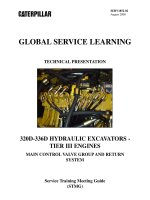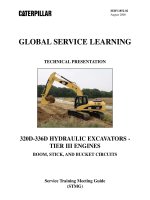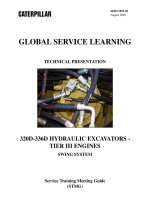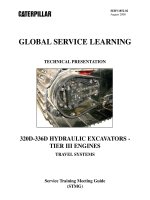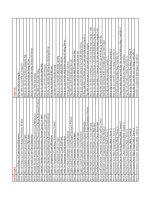D 3407 78 (1994)e1 scan
Bạn đang xem bản rút gọn của tài liệu. Xem và tải ngay bản đầy đủ của tài liệu tại đây (454.8 KB, 6 trang )
[{[b
NOTICE: This standard has either been superseded and replaced by a new version or discontinued.
Contact ASTM International (www.astm.org) for the latest information.
Designation: D 3407 - 78 (Reapproved 1994)''
An
American National Standard
PMERICAN SOCIETY FOR TESTINGAND MATERIALS
1916 Race St Philadelphia, Pa 19103
Reprinted from the Annual Book of ASTM Standards Copyright ASTM
If not listed in the current combined index, will appear in the nix? edrtion
Standard Test Methods for
Joint Sealants, Hot-Poured, for Concrete and Asphalt
Pavements
This standard is issued under the fixed designation D 3407; the number immediately following the designation indicates the year of
original adoption or, in the case of revision, the year of last revwon. A number in parentheses indicates the year of last reapproval. A
superscript epsilon ( E ) indicates an editorial change since the last revision or reapproval.
fi
NOTE-Keywords were added editonally in June 1994.
1. Scope
1.1 These test methods cover the following tests for
bituminous hot-poured types of joint sealants for portland
cement concrete and asphaltic concrete pavements: cone
penetration, now, bond at low temperatures, resilience,
asphalt compatibility, and prolonged heating.
1.2 This standard does not purport to address all of the
safety concerns, if any, associated with its use. It is the
responsibility of the user of this standard to establish appro-
priate safety and health practices and determine the applicability of regulatory limitations prior to use.
2. Referenced Documents
2.1 ASTM Standards:
C 33 Specification for Concrete Aggregates'
C 150 Specification for Portland Cement3
C 192 Practice for Making and Curing Concrete Test
Specimens in the Laboratory2
D 5 Test Method for Penetration of Bituminous Mate*als4
D 2 17 Test Method for Cone Penetration of Lubricating
Greases
D 1074 Test Method for Compressive Strength of Bituminous Mixtures4
D 1559 Test Method for Resistance to Plastic Flow of
Bituminous Mixtures Using Marshall Apparatus4
D 1561 Practice for Preparation of Bituminous Mixture
Test Specimens by Means of California Kneading
Compactor"
3. Sample Preparation
3.1 Select a sample of the fresh material, weighing approximately 600 g, in such a manner as to avoid inclusion of the
surface layer or any container liner. Heat 200 g of the sample
in a clean oil-jacketed melter equipped with mechanical
agitation (see Figs. 1 and 2) to a pouring consistency. The
temperature of the oil bath shall not exceed the safe heating
1 These test methods a n under the jurisdiction of ASTM Committee D-I on
Road and Paving Materials and are the direct responsibility of Subcommittee
w 4 . 3 3 on Formed-In-Place Sealants for Joints and Cracks in Pavements.
Current edition approved Dec. 29, 1978. Published February 1979. Originally
published as D 3407 75 T.Last PreviOüS edition D 3407 - 75 T.
Annual Book of ASTM Standards, Vol 04.02.
Annual Book oJASTM Standards, Vol 04.0 l .
Annual Book of ASTM Standards, Vol 04.03.
5 Annual Book oJASTM Standards, Vol 05.0 I.
-
temperature by more than 75'F (42°C)and, in no case, shall
be more than 550°F (288"). Add the remaining 400 g, in
quantities of approximately 50 g at a time, to the melted
material, continuing agitation. Continue the heating and
stimng until the entire sample is at the maximum safe
heating temperature.
4. Standard Conditions
4.1 The laboratory atmospheric conditions, hereinafter
referred to as standard conditions, shall be: temperature 75 f
7°F (24 f 4T), and relative humidity 50 k 10 %. The specimens prepared as hereinafter prescribed shall be stored
under standard conditions until needed for testing.
5. Penetration
5.1 Make this test in accordance with Test Method D 5 ,
except use a penetration cone in place of the standard
penetration needle. The cone shall conform to the requirements given in Test Methods D 2 17, except that the interior
construction may be modified as desired. The total moving
weight of the cone and attachments shall be 150.0 2 O. 1 g.
6. Flow
6.1 Test Specimens-Pour a portion of the sample prepared in accordance with Section 3 into a suitable (See Note
1) mold of 40 mm wide by 60 mm long by 3.2 mm deep,
placed on a bright tin panel. Fill the mold with an excess of
material, Allow the test specimen to cool at room temperature for at least '12 h; then trim the specimen flush with the
face of the mold with a heated metal knife or spatula.
NOTEI-A release agent should be used where it is necessary to
separate the material being tested from the metai. A nontoxic, waterwashable, release agent recommended for this purpose is prepared by
grinding into a smooth paste a mixture of approximately 50 % talc,
35 X glycerin and IS % by weight of a water-soluble medical lubricant.6
6.2 Procedure-Remove the mold and place the panel
containing the sample in a forced-draft oven maintained at
140 k 2'F (60 ii 1.1"C) for 5 h. During the test, mount the
panel so that the longitudinal axis of the specimen is at an
angle of 75 f 1" with the horizontal, and the transverse axis
is horizontal. Measure the change in length in millimetres of
the specimen during the 5-h test period, and report as the
flow.
KY Jelly, available at drug stores, has been found suitable for this purpose
= 0759530 0543379
82b
m
OPER&TING S I M
PLAN
-
END VIEW
ELEVATION
DRIVE AND FRAME
FIG. 1 Joint Sealant Laboratory Melting Unit
7. Bond
neously is shown in Fig. 3.
7.2 Concrete-Block Preparation:
7.2.1 The aggregate shall conform to Specification C 33,
except as specified herein. The aggregate grading shall be as
shown in Table 1. The coarse aggregate shall consist of
crushed limestone (plus 95 96 Caco,) having a water absorption of not more than 1.5 %. The fine aggregate shall consist
of crushed limestone and shall be manufactured from the
same parent rock as the coarse aggregate. The portland
cement shall conform to Specification C 150, Type II. The
7.1 Extension Machine-The extension machine used in
the bond test shall be so designed that the specimen can be
expanded 0.50 in. (12.7 mm) at a uniform rate of approximately Ya in. (3.2 mm)/h. It shall consist essentially of one or
more screws rotated by an electric motor through suitable
gear reductions. Self-aligning plates or grips, one fixed and
the other camed by the rotating screw or screws, shall be
provided for holding the test specimen in position during the
test. A machine suitable for testing three specimens simulta2
-~
~~
~
m 0759510
0543380 548
m
WIRINO DIAGRAM
,&kVATION
ESSENTIAL PARTS
SOVLR DETAILS
FIG. 2
Joint Sealant Laboratory Melting Unit
contact with the vertical sides of the mold using a 40 by
60-grit diamond saw blade at a peripheral speed of 10 O00 k
250 ft/min (3050 f 75 m/min). While the blocks are still wet
from the sawing operation, scrub the surfaces of the blocks
lightly with a stiff-bristle brush while holding under a stream
of running water. Store the blocks under lime-saturated
water maintained at standard-condition temperature. Stocks
of prepared blocks may be stored under standard conditions
indefinitely, but immerse such blocks in lime-saturated water
for not less than 7 days prior to use.
7.2.4 On removal from the storage water, again scrub the
2 by 3-in. (50 by 75-mm) faces of the blocks lightly with a
stiff-bristle brush while holding the blocks under running
water. When this operation is completed on individual
blocks, again place them under water until all blocks to be
used are prepared. When all blocks are scrubbed, remove
them from the water and lightly (under laboratory standard
conditions) blot with an oil-free, soft, absorbent cloth or
paper to remove all free surface water.
7.3 Test Specimens-Prepare three test specimens. Mold
each test specimen between two concrete blocks, as follows:
Place four treated5 brass spacer strips, approximately 'h in.
(6.4 mm) thick, on a treated metal plate base to enclose an
open space Y2 in. (13 mm) wide and 2 in. (50 mm) long.
Place the blocks on the spacer strips and space them 0.500 I
0.005 in. (12.70 f O. 13 mm) apart by means of treated metal
concrete shall have a water-cement ratio of 0.49, a cement
factor of 6.0 k 0.5 bags of cement per cubic yard (335 i 30
kg/m3), and a slump of 2%f V i in. (63 f I3 mm). The ratio
of fine aggregate to total aggregate shall be approximately
40 % by solid volume. The air content shall be 5.0 f 0.5 96
and shall be obtained by the addition to the batch of an
air-entraining agent such as a neutralized thermoplastic
resin.' The mold shall be of metal and shall be provided with
a metal base plate. Means shall be provided for securing the
base plate to the mold. The assembled mold and base plate
shall be water-tight and shall be oiled with mineral oil before
use. The inside depth of the mold shall be 3 in. (75 mm).
Prepare the concrete in accordance with the procedure
described in Specification C 192.
7.2.2 Fill the mold with concrete to overflowing and
vibrate externally for 30 s. Screed (level) the concrete to a
smooth surface with a wooden float and finally level off with
a metal straightedge drawn across the top with a sawing
motion. Cure as specified in Specification C 192.
7.2.3 After curing for not less than 14 days, cut the
concrete blocks into 1 by 2 by 3-in. (25 by 50 by 75-mm) test
blocks, discarding the I-in., (25-mm) strips that were in
' Vinsol
resin, made by Hercules Inc., has been found satisfactory for this
purpose.
3
~~
~
~~
O759530 0543383 484
D3407
defects are apparent, the specimen shall be discarded.
7.4 Extension at Low Temperaíure-Place three test specimens, prepared as described above, in an atmosphere
maintained at the specified temperature within f2'F ( 1 . 1°C)
for not less than 4 h; then remove the treated metal spacer
blocks and mount the specimens immediately in the selfaligning clamps of the extension machine. Extend the
specimens Y4 in. (6.4 mm) at a uniform rate of approximately
Ys in. (3.2 mm)/h. During this period, maintain the atmosphere surrounding the test specimens at -20 2 2°F (-29 f
1.1"C).
7.4.1 Alternate Procedure-Extend the specimens Y2 in.
(12.7 mm) at a uniform rate of approximately Ys in. (3.2
mm)/h. During this period, maintain the atmosphere surrounding the test specimens at O i 2°F (- 17.8 f 1 . 1 T).
7.5 Recompression-After extension as described in 7.4,
remove the specimens from the extension machine and
return to storage at room temperature for 2 h. Replace the
Y2-in. (13-mm) metal spacer blocks between the concrete
blocks and rest each specimen on one concrete block so that
the weight of the top block recompresses the joint sealant.
7.6 Number of Cycles-Three cycles of extension, followed by recompression, shall constitute one complete test
for bond.
blocks Y2 in. (13 mm) thick placed at such distances from the
ends that an opening 0.500 f 0.005 in. by 2.000 f 0.005 in.
by 2.000 i 0.005 in. (12.70 f 0.13 mm by 50.80 f 0.13 mm
by 50.80 It 0.13 mm) is formed between the blocks with a
%-in. (6.4-mm) opening below the blocks. Rubber bands,
clamps, or similar suitable means may be used to hold the
blocks in position. Place treated brass side wails 1 in. (25
mm) high on top of the blocks. Pour material prepared in
accordance with Section 3 into the space between the blocks
in sufficient quantity to bring flush with the top of the spacer
strips. After the specimen has cooled for at least 2 h, remove
the excess material protruding beyond the top and bottom of
the blocks by cutting with a heated metal knife or spatula. If
shrinkage of the material upon cooling reduces its level
below the top of the concrete blocks, or if other casting
TABLE 1 Aggregate Grading
TYP
Coarse aggregate
Sieve Size
U in. (19.0 rnm)
!4 in. (12.5 mm)
?
in.i
(9.5 mm)
Fine aggregate
N0.4 (4.75 Mn)
No. 4 (4.75mrn)
No. 8 (2.36 mm)
No. 16 (1.18 mm)
m.30 (soow)
No.50 (300pm)
No. 100 (150 pm)
% Passing
97 to 100
63 to 69
30 to 36
Oto3
100
a2 to a8
60 to 70
40 to 50
8. Resilience
8.1 Test Specimens-One
16 to 26
Sto9
4
specimen shall be prepared as
the container rim. Compute the recovery (a measure of
resilience) as follows:
Recovery, % = P + 100 - F
Record the average of three determinations as the resilience.
9. Asphalt Compatibility
9.1 Preparation of Specimens:
9. I . 1 Prepare duplicate test specimens not less than 4 in.
(100 mm) in diameter and 2‘12 in. (63 mm) in height of
hot-mix asphaltic concrete, using 85 to 100 penetration
asphalt cement.
NOTE2-Specimens prepared in accordance with Test Method
m-t
O.2ltO
D 1559, Method D 1561, or Test Method D 1074 are suitable for this
purpose. Specimens that are other than circular, but with similar
dimensions and properties, are also acceptable. Density and asphalt
content of the specimens will be those values which would be specified
in an asphaltic concrete pavement mix design, using the design method
specified by the purchasing agency.
Matoriol : Stool
a b
O 0
3? k?
--
WoigM of boll : 2ZSgmmr plu#
Q minus 0.1 grom
loial woight ot ban and
ponohomotor rho* : 7 6 grams
9.1.2 Allow the test specimens to cool to room temperature, after which cut a groove 4 in. (100 mm) long by ‘12 Ys
in. (1 3 t 3.2 mm) wide by 3/4 i in. (1 9 3.2 mm) deep in
the top surface of each specimen by wet sawing with a
power-driven masonry saw. Scrub the grooves thus formed
with a stiff-bristle brush while holding specimens under
running water to remove all residue from sawing. Allow the
specimens to dry and return to room temperature, after
which securely wrap them with clothbacked adhesive tape, or
otherwise reinforce to prevent slumping or collapse during
the ensuing test period. Caulk the ends of the grooves to
prevent leaking. Pour joint sealant prepared as described in
Section 3 into the grooves, overfilling the grooves slightly.
However, allow no joint sealant to overflow onto the surface
of the asphaltic concrete adjacent to the grooves. After the
sealing compound has cooled to room temperature, remove
any overfill of sealing compound with a hot knife blade, so
that the surface of the sealing compound is even with the
surface of the specimens.
9.2 Procedure-Place the duplicate specimens in a forceddraft oven maintained at a temperature of 140 5°F (60 &
3°C) for 72 h. Inspect the specimens at least once each day to
prevent slumping or collapse during the test period.
9.3 Compatibility Test Results-Immediately after removing from the oven and again after cooling to room
temperature, examine the specimens for incompatibility of
the joint sealant with the asphaltic concrete.
*
*
FIG. 4 Ball Penetration Tool
specified in Section 5 , using a 6-oz (177.5 cm3)ointment can
and the specimens shall be cured 24 h under standard
laboratory conditions prior to testing.
8.2 Procedure-Test the specimen (conditioned for at
least 1 h in a water bath maintained at 77 t 0.2’F (25 i
0.1’C)) with a standard penetrometer in which the ball
penetration tool shown in Fig. 4 has been substituted for the
needle. Coat the ball of the penetrometer lightly with glycerin
or talc. Proceed as follows: Place the bail of the penetrometer
in contact with the surface of the specimen and set the
indicating dial to zero. Position a light so that initial contact
of the ball with the surface of the specimen can be observed
readily. Release the ball penetration tool, allow it to penetrate the specimen for 5 s, and record the reading as ball
penetration, P, in centimetres to the nearest hundredth.
Without returning the dial pointer to zero, press the ball
penetration tool down an additional 100 (that is, to a reading
of P + 100) at a uniform rate in I O s. Reengage the clutch to
hold the tool down for an additional 5 s, and during this time
return the dial to zero. Release the clutch, allow the
specimen to recover for 20 s, and record the final dial
reading, F. Make determinations at three points equally
spaced from each other and not less than L/z in. (1 3 mm) from
*
10. Prolonged Heating
10.1 Prepare the sample of joint sealant as indicated in
Section 3, except hold the temperature at the manufacturer’s
recommended pouring temperature instead of the safe
heating temperature. Stir continuously for 6 h and at the end
of such period of time pour the sealant and test as indicated
in this method.
11. Keywords
1 1.1 hot-applied; joint sealant
5
W 07.59520 0543383 257
=
The American Society for Testing and M8te&/S takes no position raspmting the validity of any patent rights asserted in connection
with any irem mentioned in this standard. Users of this standard are expressly advised that determination of the validity of any such
palent rights, and the risk of infringement of such rights, are entirely their own responsibliity.
This stendwd is subject to revision at any time by the responsible technlcel committee and must be reviewed every five years and
if not revised, either reapproved or withdrawn. Your comments are invited either for revision of this standard or for addirional standards
and should be addressed to ASTM Heedquarters. Your comments will receive carefui consideraiion at a meeting of the responsible
technical committee, which you mey attend. if you feel that your comments hava not received a fair hearing you should make your
views known to the ASTM Committee on Standards, 1916 Race St., Philedeiphia, PA 19103.
6




